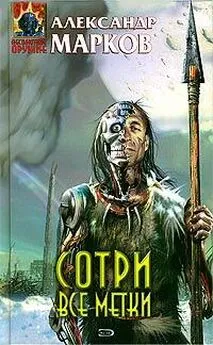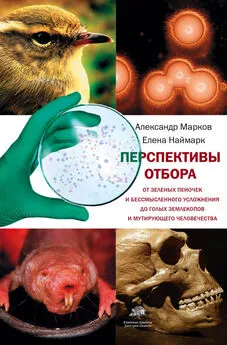Александр Марков - Перспективы отбора. От зеленых пеночек и бессмысленного усложнения до голых землекопов и мутирующего человечества
- Название:Перспективы отбора. От зеленых пеночек и бессмысленного усложнения до голых землекопов и мутирующего человечества
- Автор:
- Жанр:
- Издательство:АСТ, Corpus
- Год:2019
- Город:Москва
- ISBN:978-5-17-114115-8
- Рейтинг:
- Избранное:Добавить в избранное
-
Отзывы:
-
Ваша оценка:
Александр Марков - Перспективы отбора. От зеленых пеночек и бессмысленного усложнения до голых землекопов и мутирующего человечества краткое содержание
Перспективы отбора. От зеленых пеночек и бессмысленного усложнения до голых землекопов и мутирующего человечества - читать онлайн бесплатно ознакомительный отрывок
Интервал:
Закладка:
7. Beauchamp J. P. 2016. Genetic evidence for natural selection in humans in the contemporary United States // Proc Natl Acad Sci USA. V. 113. P. 7774–7779.
8. Brawand D. et al. 2014. The genomic substrate for adaptive radiation in African cichlid fish // Nature. V. 513. P. 375–381.
9. Buffington S. A. et al. 2016. Microbial reconstitution reverses maternal diet-induced social and synaptic deficits in offspring // Cell. V. 165. P. 1762–1775.
10. Camperio-Ciani A. et al. 2004. Evidence for maternally inherited factors favouring male homosexuality and promoting female fecundity // Proc Biol Sci. V. 271. P. 2217–2221.
11. Carazo P. et al. 2014. Within-group male relatedness reduces harm to females in Drosophila // Nature. V. 505. P. 672–675.
12. Coleman S. W. et al. 2009. Reproductive isolation, reproductive mode, and sexual selection: empirical tests of the viviparity-driven conflict hypothesis // Am Nat. V. 173. P. 291–303.
13. Condon M. A. et al. 2014. Lethal interactions between parasites and prey increase niche diversity in a tropical community // Science. V. 343. P. 1240–1244.
14. Corral-López A. et al. 2017. Female brain size affects the assessment of male attractiveness during mate choice // Sci Adv. V. 3. P. e1601990.
15. Crabtree G. R. 2013. Our fragile intellect. Part II // Trends Genet. V. 29. P. 3–5.
16. Daly M., Wilson V. 1988. Evolutionary social psychology and family homicide // Science. V. 242. P. 519–521.
17. Dannemann M. et al. 2016. Introgression of Neandertal- and Denisovan-like haplotypes contributes to adaptive variation in human Toll-like receptors // Am J Hum Genet. V. 98. P. 22–33.
18. Deschamps M. et al. 2016. Genomic signatures of selective pressures and introgression from archaic hominins at human innate immunity genes // Am J Hum Genet. V. 98. P. 5–21.
19. Diss G. et al. 2017. Gene duplication can impart fragility, not robustness, in the yeast protein interaction network // Science. V. 355. P. 630–634.
20. Endler J. A. 1980. Natural selection on color patterns in Poecilia reticulata // Evolution. V. 34. P. 76–91.
21. Fuentes I. et al. 2014. Horizontal genome transfer as an asexual path to the formation of new species // Nature. 2014. V. 511. P. 232–235.
22. Gasparini C. et al. 2012. Cross-generational effects of sexual harassment on female fitness in the guppy // Evolution. V. 66. P. 532–543.
23. Ghalambor C. K. et al. 2015. Non-adaptive plasticity potentiates rapid adaptive evolution of gene expression in nature // Nature. V. 525. P. 372–375.
24. Gibson A. K. et al. 2017. The two-fold cost of sex: experimental evidence from a natural system // Evol Lett. 2017. V. 1. P. 6–15.
25. Good B. H. et al. 2017. The dynamics of molecular evolution over 60,000 generations // Nature. V. 551. P. 45–50.
26. Grant P. R., Grant B. R. 2006. Evolution of character displacement in Darwin’s finches // Science. V. 313. P. 224–226.
27. Grant P. R., Grant B. R. 2014. Speciation undone // Nature. V. 507. P. 178–179.
28. Gross J., Bhattacharya D. 2010. Uniting sex and eukaryote origins in an emerging oxygenic world // Biol Direct. V. 5. P. 53.
29. Hamer D., Sirota L. 2000. Beware the chopsticks gene // Mol Psychiatry. V. 5. P. 11–13.
30. Harris K. 2015. Evidence for recent, population-specific evolution of the human mutation rate // Proc Natl Acad Sci USA. V. 112. P. 3439–3444.
31. Hart S. A. et al. 2013. Expanding the environment: gene × school-level SES interaction on reading comprehension // J Child Psychol Psychiatry. V. 54. P. 1047–1055.
32. Highton R. 1998. Is Ensatina eschscholtzii a ring-species? // Herpetologica. V. 54. P. 254–278.
33. Hooper D. M., Price T. D. 2015. Rates of karyotypic evolution in Estrildid finches differ between island and continental clades // Evolution. V. 69. P. 890–903.
34. Hooper D. M., Price T. D. 2017. Chromosomal inversion differences correlate with range overlap in passerine birds // Nat Ecol Evol. V. 1. P. 1526–1534.
35. Hsiao E. Y. et al. 2013. Microbiota modulate behavioral and physiological abnormalities associated with neurodevelopmental disorders // Cell. V. 155. P. 1451–1463.
36. Inoue Y. et al. 2017. Evolution of the wheat blast fungus through functional losses in a host specificity determinant // Science. V. 357. P. 80–83.
37. Johnston S. E. et al. 2013. Life history trade-offs at a single locus maintain sexually selected genetic variation // Nature. V. 502. P. 93–95.
38. Jónsson H. et al. 2017. Parental influence on human germline de novo mutations in 1,548 trios from Iceland // Nature. V. 549. P. 519–522.
39. Keagy J. et al. 2009. Male satin bowerbird problem-solving ability predicts mating success // Anim Behav. V. 78. P. 809–817.
40. Kleindorfer S. et al. 2014. Species collapse via hybridization in Darwin’s tree finches // Am Nat. V. 183. P. 325–341.
41. Kong A. et al. 2017. Selection against variants in the genome associated with educational attainment // Proc Natl Acad Sci USA. V. 114. P. e727–e732.
42. Kopelman P. 2000. Obesity as a medical problem // Nature. V. 404. P. 635–643.
43. Krakowiak P. et al. 2012. Maternal metabolic conditions and risk for autism and other neurodevelopmental disorders // Pediatrics. V. 129. P. e1121–e1128.
44. Kulmuni J., Pamilo P. 2014. Introgression in hybrid ants is favored in females but selected against in males // Proc Natl Acad Sci USA. V. 111. P. 12805–12810.
45. Lack D. 1947. Darwin’s finches. Cambridge University Press.
46. Lamichhaney S. et al. 2016. A beak size locus in Darwin’s finches facilitated character displacement during a drought // Science. V. 352. P. 470–474.
47. Lamichhaney S. et al. 2018. Rapid hybrid speciation in Darwin’s finches // Science. V. 359. P. 224–228.
48. Langergraber K. E. et al. 2012. Generation times in wild chimpanzees and gorillas suggest earlier divergence times in great ape and human evolution // Proc Natl Acad Sci USA. V. 109. P. 15716–15721.
49. Lee S.-G. et al. 2017. Age-associated molecular changes are deleterious and may modulate life span through diet // Sci Adv. V. 3. P. e1601833.
50. Levy S. F. et al. 2015. Quantitative evolutionary dynamics using high-resolution lineage tracking // Nature. V. 519. P. 181–186.
51. Liebers D. et al. 2004. The herring gull complex is not a ring species // Proc Biol Sci. V. 271. P. 893–901.
52. Lukas D., Huchard E. 2014. The evolution of infanticide by males in mammalian societies // Science. V. 346. P. 841–844.
53. Łukasiewicz A. et al. 2017. Kin selection promotes female productivity and cooperation between the sexes // Sci Adv. V. 3. P. e1602262.
54. Lumley A. J. et al. 2015. Sexual selection protects against extinction // Nature. V. 522. P. 470–473.
55. Lynch M. 2010a. Evolution of the mutation rate // Trends Genet. V. 26. P. 345–352.
56. Lynch M. 2010b. Rate, molecular spectrum, and consequences of human mutation // Proc Natl Acad Sci USA. V. 107. P. 961–968.
57. Lynn R. 1999. New evidence for dysgenic fertility for intelligence in the United States // Soc Biol. V. 46. P. 146–153.
58. Makarova K. S. et al. 2005. Ancestral paralogs and pseudoparalogs and their role in the emergence of the eukaryotic cell // Nucleic Acids Res. V. 33. P. 4626–4638.
59. Markov A. V., Kaznacheev I. S. 2016. Evolutionary consequences of polyploidy in prokaryotes and the origin of mitosis and meiosis // Biol Direct. V. 11. P. 28.
60. Martins M. J. F. et al. 2018. High male sexual investment as a driver of extinction in fossil ostracods // Nature. V. 556. P. 366–369.
61. McDonald M. J. et al. 2016. Sex speeds adaptation by altering the dynamics of molecular evolution // Nature. V. 531. P. 233–236.
62. Meirmans S. et al. 2012. The costs of sex: facing real-world complexities // Q Rev Biol. V. 87. P. 19–40.
63. Nadeau N. J. et al. 2016. The gene cortex controls mimicry and crypsis in butterflies and moths // Nature. V. 534. P. 106–110.
64. Nowak M. A. et al. 2010. The evolution of eusociality // Nature. V. 466. P. 1057–1062.
65. Okbay A. et al. 2016. Genome-wide association study identifies 74 loci associated with educational attainment // Nature. V. 533. P. 539–542.
66. Ostrovsky A. N. et al. 2015. Matrotrophy and placentation in invertebrates: a new paradigm // Biol Rev Camb Philos Soc. V. 91. P. 673–711.
67. Ozawa H. 2013. The history of sexual dimorphism in Ostracoda (Arthropoda, Crustacea) since the Palaeozoic // Sexual Dimorphism. InTech open.
68. Panchin A. Y. et al. 2014. Midichlorians — the biomeme hypothesis: is there a microbial component to religious rituals? // Biol Direct. V. 9. P. 14.
69. Penz O. K. et al. 2015. Protracted brain development in a rodent model of extreme longevity // Sci Rep. V. 5. P. 11592.
70. Podgornaia A. I., Laub M. T. 2015. Pervasive degeneracy and epistasis in a protein-protein interface // Science. V. 347. P. 673–677.
71. Poduri A. et al. 2013. Somatic mutation, genomic variation, and neurological disease // Science. V. 341. P. 1237758.
72. Pollux B. J. A. et al. 2014. The evolution of the placenta drives a shift in sexual selection in livebearing fish // Nature. V. 513. P. 233–236.
73. Poutahidis T. et al. 2013. Microbial symbionts accelerate wound healing via the neuropeptide hormone oxytocin // PLoS One. V. 8. P. e78898.
74. Reznick D. N. et al. 2002. Independent origins and rapid evolution of the placenta in the fish genus Poeciliopsis // Science. V. 298. P. 1018–1020.
75. Rietveld C. A. et al. 2013. GWAS of 126,559 individuals identifies genetic variants associated with educational attainment // Science. V. 340. P. 1467–1471.
76. Roberts E. K. et al. 2012. A Bruce effect in wild geladas // Science. V. 335. P. 1222–1225.
77. Romiguier J. et al. 2014. Comparative population genomics in animals uncovers the determinants of genetic diversity // Nature. V. 515. P. 261–263.
78. Saha S. et al. 2009. Advanced paternal age is associated with impaired neurocognitive outcomes during infancy and childhood // PLoS Med. V. 6. P. e40.
79. Sankararaman S. et al. 2014. The genomic landscape of Neanderthal ancestry in present-day humans // Nature. V. 507. P. 354–357.
80. Scally A., Durbin R. 2012. Revising the human mutation rate: implications for understanding human evolution // Nat Rev Genet. V. 13. P. 745–753.
81. Shendure J., Akey J. M. 2015. The origins, determinants, and consequences of human mutations // Science. V. 349. P. 1478–1483.
82. Shohet A. J., Watt P. J. 2009. Female guppies Poecilia reticulata prefer males that can learn fast // J Fish Biol. V. 75. P. 1323–1330.
83. Simonti C. N. et al. 2016. The phenotypic legacy of admixture between modern humans and Neanderthals // Science. V. 351. P. 737–741.
84. Skirbekk V. 2008. Fertility trends by social status // Demogr Res. V. 18. P. 145–180.
Читать дальшеИнтервал:
Закладка:





